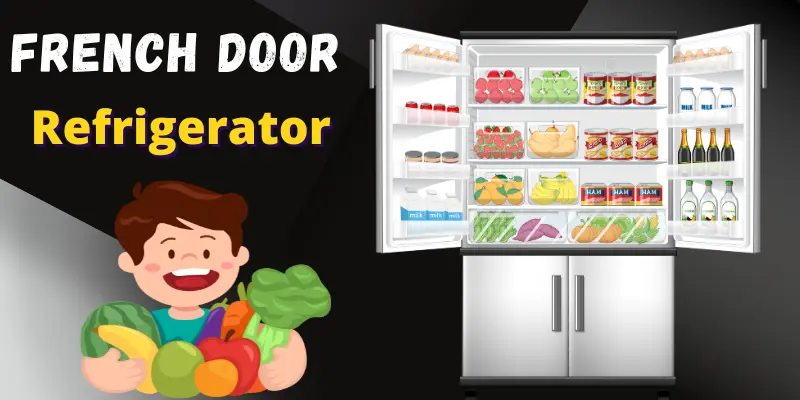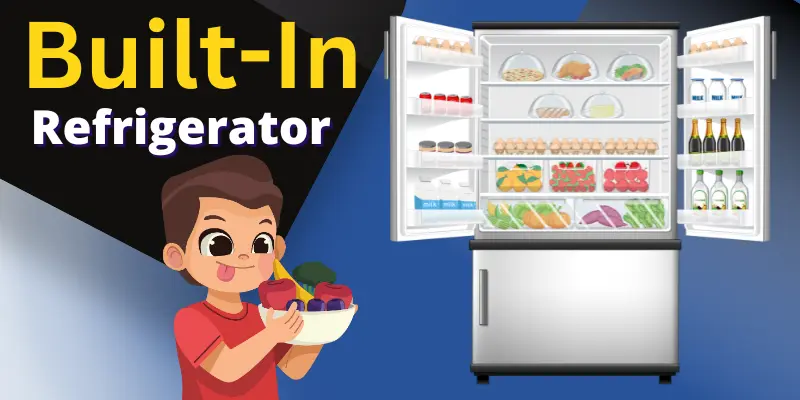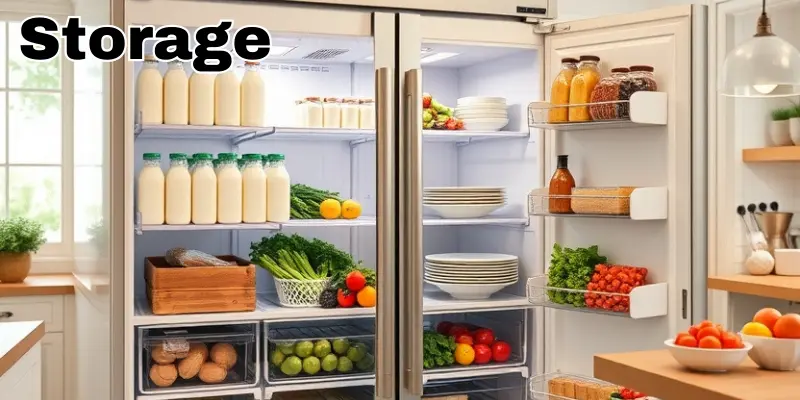What is the Difference Between a French Door and a Built-In Refrigerator?
Published: 25 Sep 2025
Refrigerators come in many styles, but two popular types stand out—French door and built-in refrigerators. Each type serves different needs and offers unique benefits. In this article, we will explain what is the difference between a French door and a built-in refrigerator. Are you ready? Let’s begin.
What is a French Door Refrigerator?
A French door refrigerator is stylish and convenient, with double doors on top and a freezer drawer below. It is perfect for people who need lots of space and easy access to fresh foods.
- Spacious Design: Large shelves and adjustable compartments for more storage.
- Energy Efficiency: Many models come with energy-saving features.
- Modern Features: Includes smart technology, water dispensers, and ice makers.
- Flexible Organization: Adjustable shelves make it easy to store large items.

Now that we understand a French door refrigerator, let’s move on to the second type—built-in refrigerators.
What is a Built-In Refrigerator?
A built-in refrigerator fits flush with your kitchen cabinets, creating a seamless look. It is great for modern kitchens where design and style matter the most.
- Customizable Design: You can match it with your kitchen’s style.
- Seamless Fit: Blends perfectly with your cabinetry.
- Durability: Built to last longer with sturdy materials.
- Premium Features: Offers advanced cooling, temperature control, and modern designs.

Now that we have covered both types, let’s compare them in detail to find the best fit for your needs.
Comparison Between French Door and Built-In Refrigerators
French doors and built-in refrigerators cater to different needs, but what sets them apart? This section dives deeper into key differences. Below, you’ll find a comparison table highlighting their main features, followed by a detailed breakdown for better understanding. Let’s uncover the differences!

Comparison Table:
| Feature | French Door Refrigerator | Built-In Refrigerator |
| Design | Double doors, freezer drawer | Flush fit with cabinets |
| Storage | Spacious, adjustable shelving | Limited but customizable |
| Price | Affordable to mid-range | Expensive, premium category |
| Energy Efficiency | Good, with many energy-saving options | Efficient but depends on the model |
| Installation | Freestanding, easy-to-install | Requires professional installation |
Design
When it comes to design, French doors and built-in refrigerators look very different. Each style is made for a special type of kitchen and personal need.
A French door refrigerator has two doors that open side by side on the top, giving you a wide view of the fresh food section. The freezer is usually at the bottom in a drawer, which makes it easy to reach frozen items. This style is modern, elegant, and also very practical for families.

On the other hand, a built-in refrigerator is made to blend in with your kitchen cabinets. It looks sleek and professional, giving the kitchen a luxury touch. Built-in fridges are often taller and narrower, which saves space but may limit how much you can store compared to a French door model.
Storage
Storage space is one of the biggest differences between French door and built-in refrigerators. Each option offers unique benefits depending on how much food you keep and how you like to organize it.
A French door refrigerator gives you plenty of room with wide shelves and flexible compartments. It’s perfect for families who need to store a lot of fresh food, leftovers, or large trays like pizzas and party platters. The freezer section also provides good space for frozen meals and bulk items.

A built-in refrigerator, on the other hand, is usually smaller in capacity but makes up for it with smart design. Many models allow you to customize the shelves and drawers to fit your needs. It’s a great choice for people who prefer a minimalist kitchen or want a fridge that keeps everything neat and organized without looking bulky.
Price
Price is another key factor when choosing between a French door refrigerator and a built-in refrigerator. Both come at different cost levels depending on features and design.
A French door refrigerator is available in many price ranges, from budget-friendly models to high-end versions with advanced features. This makes it easier for families to find one that fits their needs and budget. It’s a flexible option if you want style and space without spending too much.
A built-in refrigerator, however, is often more expensive. The higher cost comes from its sleek design, premium materials, and the need for professional installation. While the upfront price is high, many people see it as a long-term investment that adds value and elegance to a modern kitchen.
Energy Efficiency
Energy efficiency is an important factor when choosing a refrigerator, as it affects both your electricity bill and the environment.
French door refrigerators often come with energy-efficient models that use modern technology to reduce power consumption. Many are designed with smart sensors and features that adjust cooling based on usage, helping families save energy in the long run.

Built-in refrigerators can also be efficient, but the level of savings depends on the brand and model. Premium built-in units may have advanced cooling systems that keep food fresh while using less energy, though these models usually come at a higher price.
Installation
Installation is another big difference between French door and built-in refrigerators.
French door refrigerators are freestanding, which means you can simply plug them in and start using them right away. This makes them easy to move if you change homes or decide to rearrange your kitchen.
Built-in refrigerators, on the other hand, require professional installation so they can fit smoothly into your cabinets. While this gives a clean and polished look, it also makes them less flexible if you plan to move or remodel often.
Now that we have discussed their comparison and learned everything, let’s move forward to the next section, where we answer general questions about these two types of refrigerators.
Common Questions About French Door vs. Built-In Refrigerators
Now, let’s address the most common questions people often have when comparing French door and built-in refrigerators. These questions will help you better understand the differences and choose the right one for your kitchen.

Frequently Asked Questions:
- Which refrigerator type is easier to match with kitchen cabinets and décor?
- Do built-in refrigerators offer better air circulation than French door models?
- Which type of fridge usually comes with more advanced technology and smart features?
- How does the noise level compare between French door and built-in refrigerators?
- Are built-in refrigerators more customizable than French door refrigerators?
- Which type of refrigerator affects kitchen resale value more?
- Do French door or built-in refrigerators require more maintenance over time?
- Which refrigerator is better for organizing specialty items like wine, cheese, or deli meats?
Now we discuss the answers to all the questions one by one. Are you ready?
A built-in refrigerator is easier to match with your kitchen cabinets because it sits flush with them. It can be customized with panels that look exactly like your cabinets, giving a smooth and stylish finish. French door refrigerators, on the other hand, stand out as a separate appliance. While they can look modern, they don’t blend into the kitchen as perfectly as built-in models. If you want a seamless, professional look, built-in is the better choice.
Yes, built-in refrigerators are often designed with strong air circulation systems. They use advanced cooling technology to keep the temperature steady in every corner. French door refrigerators also have good airflow, but sometimes cold spots or uneven cooling can happen if the fridge is very full. Built-in units are built for even airflow, which helps food stay fresh longer. This makes them a popular choice for people who want premium cooling performance.
French door refrigerators usually have more advanced technology, such as touch screens, water dispensers, and smart home features. Many models include Wi-Fi controls, ice makers, and flexible temperature zones. Built-in refrigerators, while premium, often focus more on design and customization than flashy features. Some high-end built-ins do have advanced cooling systems, but they may not always include the latest smart tools. If you want the newest technology, a French door refrigerator is often the winner.
Built-in refrigerators are usually quieter because they are designed with premium materials and advanced compressors. Since they are often built into cabinets, the noise is also reduced by the surrounding woodwork. French door refrigerators can sometimes be louder, especially when the ice maker is running or the compressor is working hard. The noise level will depend on the brand and model, but in general, built-in fridges give a quieter experience. This makes them a good choice for open kitchens.
Yes, built-in refrigerators are highly customizable. You can choose different sizes, finishes, and even panel-ready designs that match your exact kitchen style. French door refrigerators don’t have as many customization options, though you can find them in different colors like stainless steel, black, or white. Built-ins let you design your fridge to look like part of your cabinets, which is why they are popular in luxury kitchens. If personalization is important, built-in refrigerators are better.
A built-in refrigerator can increase your kitchen’s resale value more than a French door refrigerator. Buyers often see built-ins as a luxury feature that adds style and class to the kitchen. French door refrigerators are also attractive, but they are easy to move or replace, so they don’t impact resale value as much. A built-in fridge makes the kitchen look like a custom design, which appeals to many buyers. If you’re thinking long-term, built-in has a stronger effect on resale value.
Built-in refrigerators usually require more maintenance because they have advanced systems and need professional servicing. Their installation makes repairs more complicated, too. French door refrigerators are easier to maintain since they can be moved or repaired more easily. However, they may need small fixes more often, such as replacing ice makers or water filters. In short, built-in lasts longer but needs expert care, while French doors are easier for everyday maintenance.
French door refrigerators are better for organizing specialty items. Many models come with dedicated drawers for cheese, deli meats, or even flexible temperature zones for wine and drinks. Built-in refrigerators are customizable but usually focus on general storage, not special compartments. If you love entertaining or keeping specialty foods fresh, French doors will give you more options. They are designed with families and variety in mind.
Now that we’ve answered some common questions about these refrigerators, let’s move on to the final point of this article: the conclusion.
Conclusion
Your journey and ours are almost coming to an end! After learning about the difference between a French door and a built-in refrigerator, we hope you now have a better understanding of which one suits your needs. Both have their unique advantages depending on your kitchen style, budget, and storage preferences. If you’re still unsure, think about your space, lifestyle, and how much storage you really need before making a choice.
If you’re looking to explore more on this topic or other refrigerators, check out our guide on the Advantages and disadvantages of French door refrigerators. and the Advantages and disadvantages of a built-in refrigerator.
Feel free to leave any questions or thoughts in the comment section. We’d love to hear from you! Plus, be sure to read our other articles to help you make the best choice for your kitchen.





